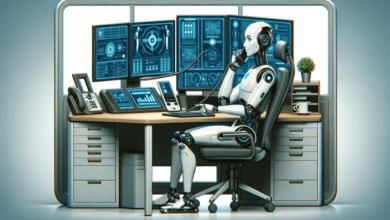
The world of design is experiencing a transformation, and artificial intelligence (AI) is at the core of this evolution. For businesses looking to integrate AI into their design processes, artificial intelligence consulting services can provide the necessary expertise to navigate this transformative technology. Once a concept of science fiction, AI has become an essential tool in the modern designer’s toolkit. Its ability to analyze data, automate repetitive tasks, and even generate new creative concepts is reshaping the way designs are conceptualized and executed.
From enhancing efficiency to opening up entirely new possibilities, AI is making design more accessible and innovative than ever. Tools like a photo collage maker now use AI to intelligently suggest layouts, improve image quality, and save time for users of all skill levels. This is just one example of how AI empowers both professionals and novices to create exceptional work.
Let’s explore how AI is revolutionizing the design world and what it means for the future of creativity.
Understanding AI in Design
AI in design involves leveraging algorithms and machine learning to streamline processes, enhance creativity, and generate designs that meet specific requirements. These tools analyze patterns, recognize trends, and even mimic human creativity, making the design process faster and more intuitive. Learn more about producing your own AI pictures generator. With AI, designers can push the boundaries of innovation and bring their creative visions to life more efficiently than ever before.
For example, AI can:
- Automate mundane tasks like resizing or color correction.
- Offer personalized design recommendations.
- Generate entirely new visual concepts.
By embracing these capabilities, designers can focus more on their creative vision rather than the technicalities.
Key Benefits of AI for Designers
1. Efficiency Gains
AI tools can handle tedious tasks like cropping, resizing, or creating multiple design variations for different platforms. This allows designers to allocate more time to creative ideation and strategy.
2. Enhanced Creativity
AI serves as a source of inspiration. Tools like DALL·E or Artbreeder can generate stunning visuals from simple prompts, helping designers explore creative directions they might not have considered.
3. Cost-Effectiveness
For startups and small businesses, AI tools provide professional-level design capabilities without the need for expensive software or teams.
4. Personalized Outputs
AI uses data to create tailored designs, ensuring that every output aligns with a specific audience or purpose.
Where AI is Making an Impact
1. Graphic Design
AI-powered platforms like Canva and Adobe Sensei simplify graphic design by automating tasks such as layout suggestions, font pairing, and color palette creation. These tools cater to both beginners and professionals, making high-quality design accessible to all.
2. Logo Creation
AI tools like Logojoy or Looka can generate unique logo concepts based on a few simple inputs. This is especially beneficial for businesses that need a quick and cost-effective branding solution.
3. UI/UX Design
In user interface (UI) and user experience (UX) design, AI analyzes user behavior to suggest improvements and create intuitive layouts. Platforms like Uizard even transform hand-drawn sketches into working prototypes.
4. Motion Graphics and Animation
AI simplifies motion graphic creation by automating transitions, predicting movements, and generating 3D animations. This is invaluable for marketers and content creators looking to enhance their video campaigns.
5. Image Editing
AI tools like Luminar and Photoshop’s Neural Filters allow for complex edits such as changing lighting or enhancing resolution with minimal effort, making image editing faster and more precise.
Challenges of AI in Design
While AI offers immense benefits, it also presents challenges that designers must navigate:
- Loss of Originality: AI-generated designs can sometimes feel repetitive or lack the personal touch of human creativity.
- Copyright Concerns: The use of existing artwork as training data raises ethical and legal questions.
- Over-Reliance on Automation: Relying too heavily on AI may stifle a designer’s ability to develop skills or think outside the box.
- Job Security Fears: Some worry that AI could reduce demand for certain design roles.
Designers should view AI as a tool to complement their skills, not replace them.
Real-Life Applications of AI in Design
1. Marketing Campaigns
AI helps businesses create targeted ads by analyzing customer preferences and generating customized visuals. This ensures higher engagement rates and improved ROI.
2. E-Commerce Platforms
AI enhances online shopping experiences by creating interactive designs, such as virtual fitting rooms or personalized product recommendations.
3. Architecture and Industrial Design
AI assists in creating sustainable architectural models and optimizing industrial designs for efficiency and functionality.
4. Educational Content
AI-powered design tools are increasingly used in educational platforms, making design learning interactive and accessible to students worldwide.
The Future of AI in Design
The future of AI in design is filled with possibilities. Some potential advancements include:
- Generative Design: AI will become more adept at creating unique concepts based on minimal input.
- Real-Time Feedback: AI could serve as a design assistant, offering suggestions during the creative process.
- Increased Accessibility: More user-friendly tools will enable individuals without formal training to produce professional-quality designs.
While AI will continue to evolve, the human touch—intuition, cultural understanding, and emotional intelligence—will remain irreplaceable. Designers will thrive by using AI as a partner in their creative journeys.
Conclusion
AI is revolutionizing the design industry, offering tools that make the creative process faster, smarter, and more accessible. From automating tedious tasks to sparking new ideas, AI empowers designers to explore their full potential.
By integrating AI thoughtfully, professionals can enhance their workflows and focus on what truly matters: crafting impactful, original designs. As the relationship between human creativity and artificial intelligence deepens, the future of design promises to be more innovative than ever before.




